Local Storage seems to be disabled in your browser.
For the best experience on our site, be sure to turn on Local Storage in your browser.
Lost Treasures: Famous American Coin & Treasure Hoards
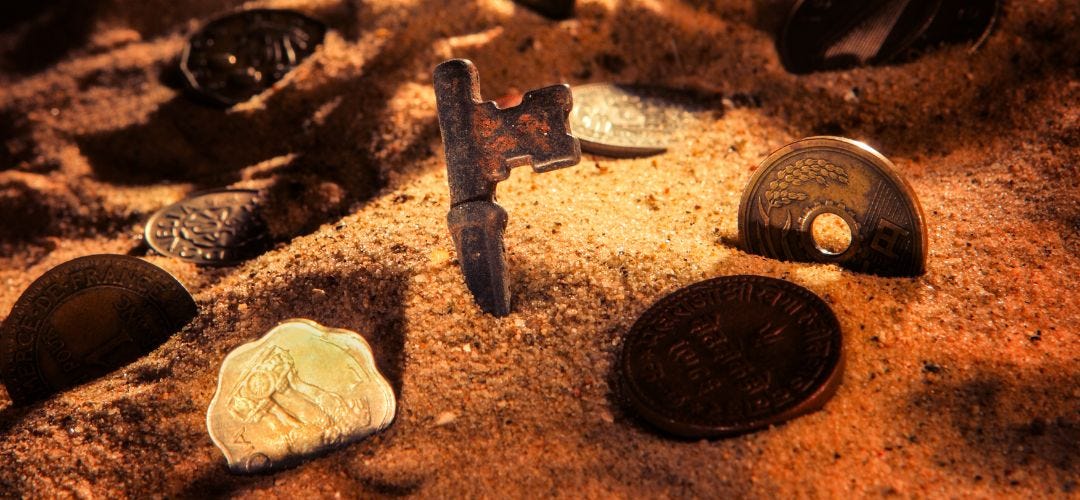
By GovMint :
People have always been fascinated with “buried treasure,” whether on land or in the sea. Over time, many great hoards of coins have been discovered, and many rare coins have been found in relatively pristine condition because they were stored away and forgotten about for generations until they were discovered.
Many existing hoards have already been found and dispersed through sales and auctions over the years, to the delight of many rare coin collectors. However, there are certainly many great coin hoards still hidden away, just waiting to be discovered.
What Is a Coin Hoard?
For most people, the term hoard infers a large quantity of something a person has gathered over a long period of time. Often, what the hoarder is passionate about is a valued collectible. A coin hoard is exactly that, a collection of coins, often ancient or of historical significance, intentionally stored or buried together and rediscovered as a single find.
In the world of numismatics, hoards can take on many forms. It may be a shoebox full of 19th-century currency notes, rolls of $10 gold pieces, or 1,000-piece bags of vintage silver dollars. Many times, the stories behind the hoards are even more exciting than the collectibles themselves. For example, the Redfield Coin Hoard led to the discovery of over 400,000 silver coins down a coal chute into a secret basement located behind a false wall. Or the Binion Silver Dollar Hoard, which is a tale steeped in drugs, affairs, and murder. More on those later.
The following are just some of the many great coin hoards discovered in America.
Castine Hoard (1840s)
One of the first buried treasure discoveries in the U.S. was the Castine Hoard of silver coins, discovered between November 1840 to April 1841, when Captain Stephen Grindle and his son Samuel unearthed many silver coins on their farm on the Bagaduce River, about six miles from the harbor of Castine, Maine. They found a coin when digging around a rock, and by dusk, they unearthed about 20 coins. But the weather turned, and a severe snowstorm covered the site, which remained snowed-in until the spring melt.
Early in the spring of 1841, they resumed digging when they came upon a large deposit of coins numbering around 500 pieces. Most pieces were foreign, like French crowns, half-crowns, quarters, and all of the reigns of Louis XIII and Louis XIV, which bore various dates from 1642 to 1682. A large portion of this first American coin hoard also consisted of the old Massachusetts, or Pine Tree, currency, of which there were around seventy-five shillings and nearly as many sixpences. Most coins were bright with little wear because they were hidden around 1690, so they could not have been in circulation very long. The number of actual pieces that were discovered was not recorded but is estimated to have been between 500 and 2,000 old silver coins.
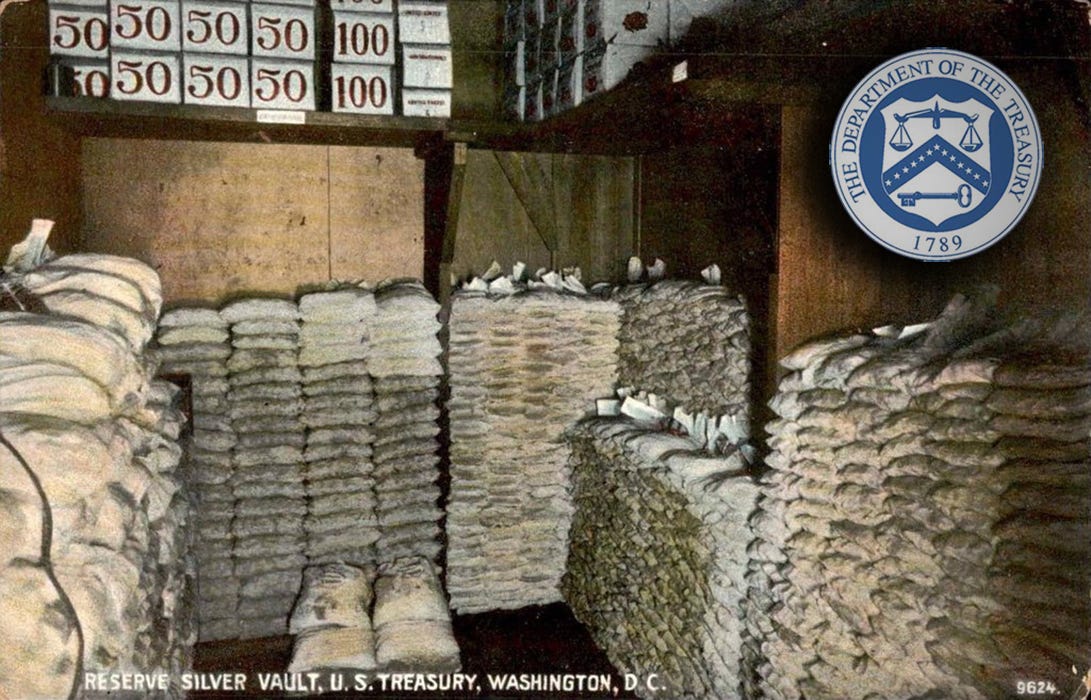

Bank of NY Hoard (1856)
The large Bank of New York coin hoard was discovered before the Civil War in 1856 when the bank's old building at 48 Wall Street was demolished. Sometime in 1788, a keg of Fugio Cents was acquired by the bank and stored deep in the basement. In 1856, a heavy keg of about 5,000 coins was discovered in the back of an old bank vault. These were not just any coins, but Benjamin Franklin-designed 1787 Fugio Cents in mint state condition, and many with beautiful brown toning from being untouched for 70 years.
The bank gave these rare pieces to its better customers as souvenirs and keepsakes over the following 92 years until 1948, when there were only 1,641 mint state Fugios remaining. The bank saw the value and appreciation of this rare coin hoard, so they saved the remaining coins in their vaults, where they stay untouched today. At the bottom of the keg was a selection of the die varieties, which the Bank of New York donated to the American Numismatic Society Museum. The bank kept the remaining coins, many in mint state condition, which still remain on the property today.
For further reading on the New York Bank Hoard, read this Coin Authority article.
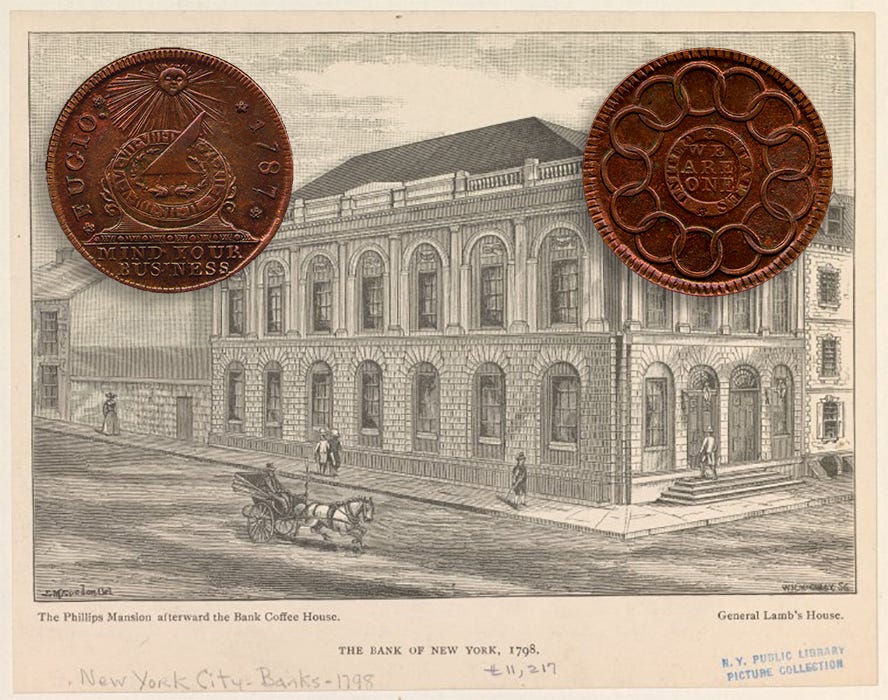

Nichols Find (1859)
One of the most famous early U.S. coin hoards is the Nichols Find. The find was a treasure trove of 1796 and 1797 copper cents that came from an original bag of cents obtained from the U.S. Mint in late 1797 or early 1798 by Senator Benjamin Goodhue, formerly of the Continental Congress. It is believed that Goodhue gave the coins to his daughters, from whom they descended in the family through marriage to David Nichols of Gallows Hill, near Salem, Massachusets. These coins came to light in 1859 when David Nichols began selling the hoard to coin dealers. He sold the coins into 1863, by which time they were worth $3 to $4 each, much lower than their present-day value.
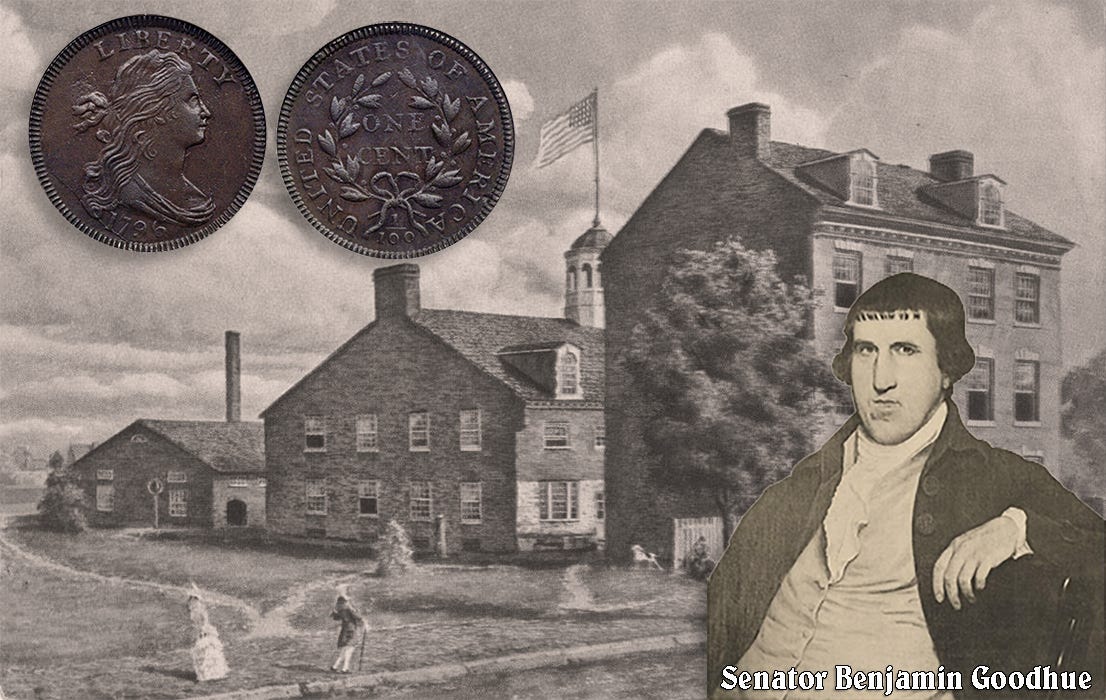

Randall Hoard (1860s)
Before, during, and after the Civil War, personal and business valuables were hidden away whenever possible from potential invading armies. A few years after the war, a contractor was hired to tear down an old railway station in Georgia. Under the train station’s loading dock, he discovered several old kegs filled with bright red-toned fifty-year-old cents.
This unsuspecting contractor found himself with thousands of coins dated 1816 to 1820, with the majority being 1818 and 1820 copper cents. The redemption window had passed, but he convinced a New England store to accept them at face value toward his debt, but customers refused them as "counterfeit," and the banks also refused the cents. Nearly all the coins were sold to coin dealer J. S. Randall at a mere ninety cents for a hundred. It took decades to disperse the "Randall Hoard." Today, the Randall Coin Hoard accounts for the most known mint state examples of these particular dated United States cents.
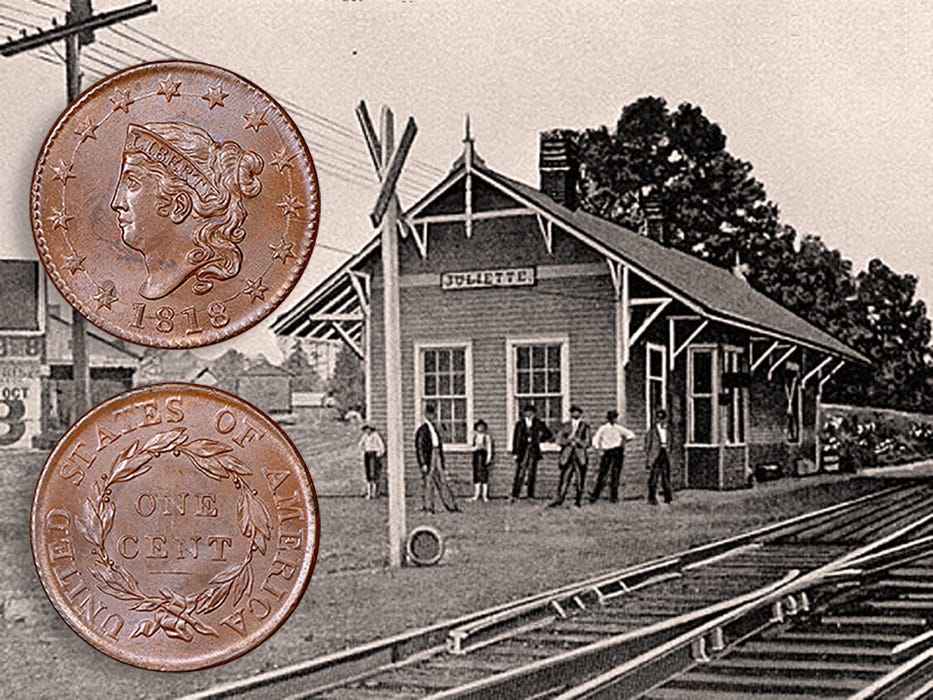

Colonel Cohen Hoard (1870s)
An old keg of coins was found in Richmond, Virginia, just prior to the Civil War. The hoard ended up in the hands of Baltimore Numismatist Colonel Mendes I. Cohen sometime in the 1870s. Colonel Cohen obtained a cache of thousands of uncirculated specimens of the 1773 Virginia half penny, which he slowly sold off over a period of years. This coin hoard was uncirculated, and most coins were toned red and were spotted or stained. These were exciting coins to view and no doubt own, as rich in history as they are in color.
In 1929, his descendants auctioned off all the remaining 2,200 coins to famous coin dealer Wayte Raymond, who purchased the remaining pieces and resold them for a profit. As a result, today, these are some of the only pre-colonial (pre-1776) American coins that can be easily obtained in mint state.
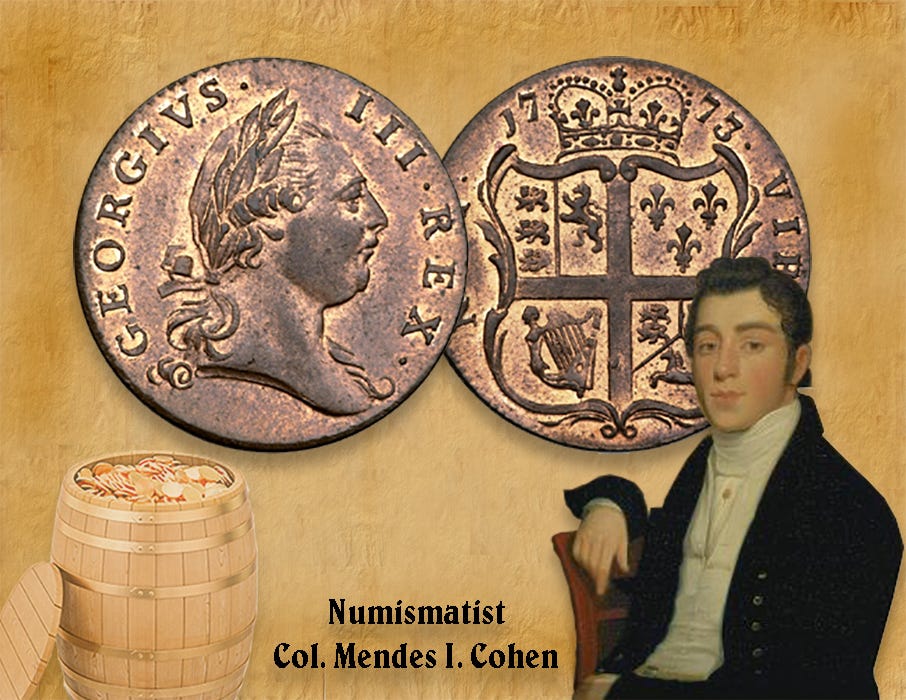

Exeter Hoard (1876)
The Exeter Hoard of Massachusetts Silver was discovered in 1876 during the excavation of a cellar near the railroad station in Exeter, New Hampshire. Reportedly, a group of 30 to 40 Massachusetts Silver Shillings were buried in the sand in what appeared to be the remains of an old wooden box. All coins bore the date 1652 and were of the Pine Tree and Oak Tree types, plus a rare Willow Tree Shilling.
In the 1650s, Early Americans would get silver coins and often bury them for their financial savings and carry copper coins for daily commerce; many of these small hoards probably exist today, just waiting to be discovered.
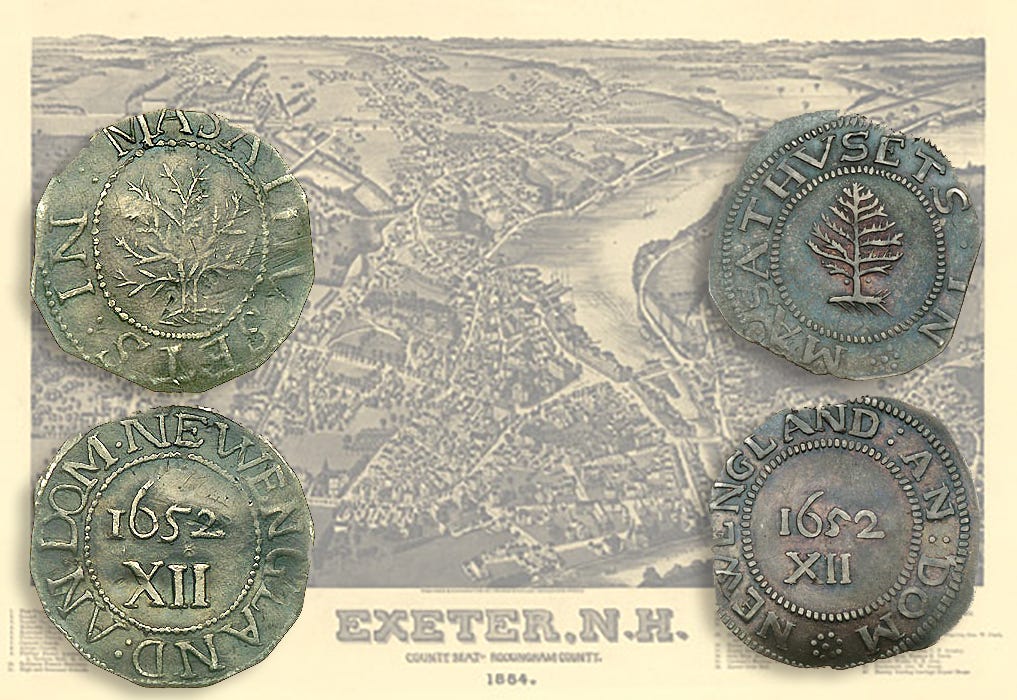

Economite Treasure (1878)
The Economite Treasure was discovered in a subterranean storage area in 1878 at Economy, Pennsylvania. This lost treasure was found in an old building erected years earlier by the Harmony Society, a utopian work-share community that placed all their goods in common. The religious sect was founded by George Rapp and was called Harmonists, Harmonites, Rappites, and the Harmony Society. Since the early 1800s, the Harmony Society established three model communities, the third located at Economy, PA, which is now Ambridge, PA. It is believed that the Harmony Society members stored their personal savings together in this subterranean storage area. Furthermore, it is believed the coins were concealed in the late 1830s in a vault that was covered in brick and mortar. Most of the coins appeared to have been taken from circulation over time and showed different degrees of wear.
The March 1881 issue of the Coin Collector's Journal featured the inventory of quarters, half-dollars, silver dollars, and foreign silver (French, Spanish, and Spanish-American coins). The total face value of the Economite Treasure was $75,000.
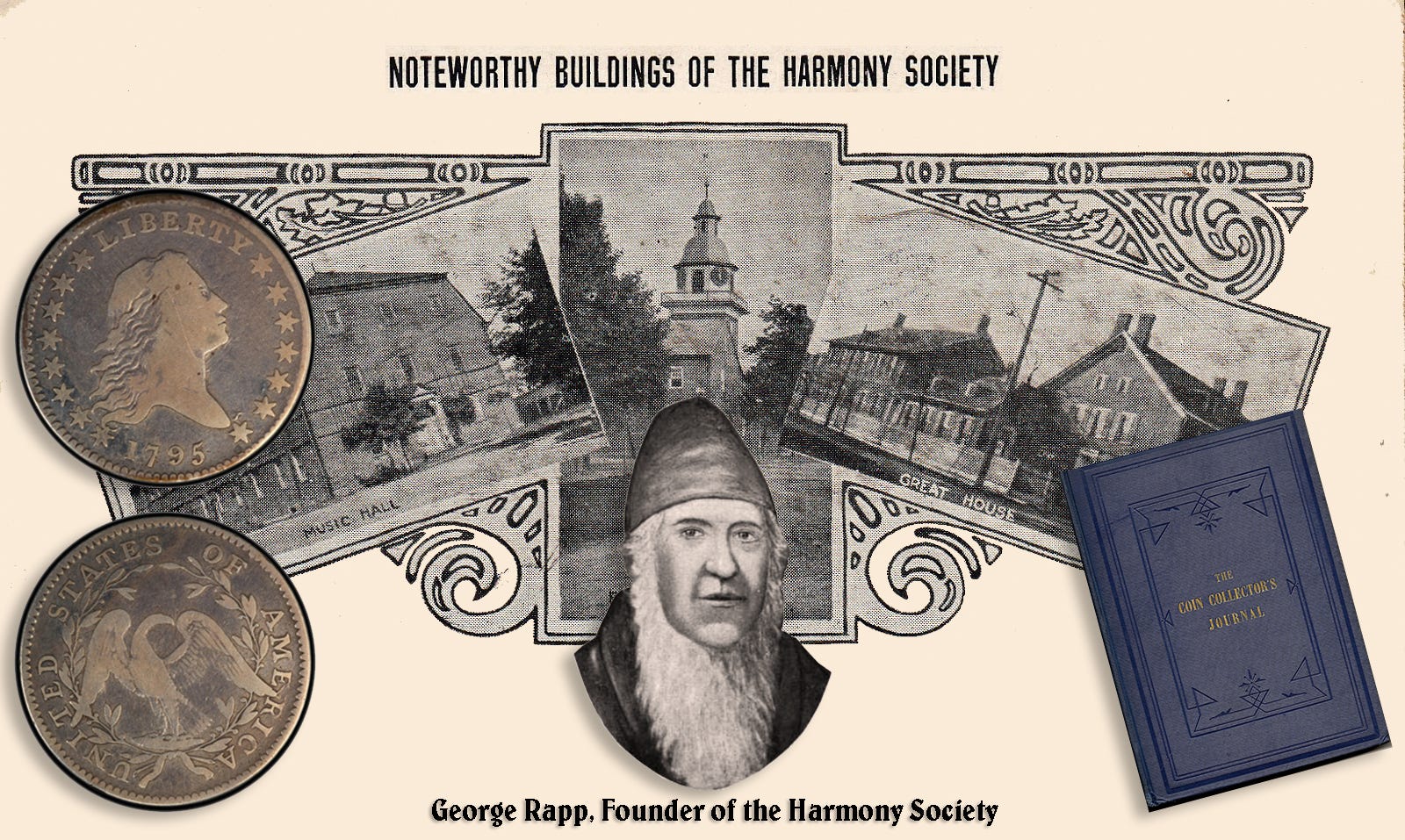

Aaron White Hoard (1888)
Aaron White was an eccentric Connecticut lawyer who believed that the financial strain of the Civil War would bankrupt America, and as a result, all paper money, "green-backs" in particular, would eventually be deemed useless and of no value. He hoarded hard money as insurance against such catastrophe, as did many Americans at the time. He wanted to remind people of the downside of paper money and even went so far as striking his own token, inscribed, “Never Keep a Paper Dollar In Your Pocket ‘Till Tomorrow.”
White was passionate about saving coins and accumulated over 100,000 pieces over his lifetime. When the coin hoard was examined several years after White's death, it was found to contain 350 gold and 100 silver dollars, 200 silver half dollars, 5,000 2-cent pieces, 60,000 large cents and 60,000 copper-nickel cents, 250 Colonials, and more than 20,000 foreign coins. The coins were placed in the hands of noted coin dealer Edouard Frossard, who sold most of them privately. His sales experienced both success and scandal, where record sales prices were recorded, but thieves stole important portions of White's collection at the sale preview. Frossard sold the rest by auction on July 20, 1888, billing them as "18,000 American and foreign copper coins and tokens selected from Aaron White hoard."
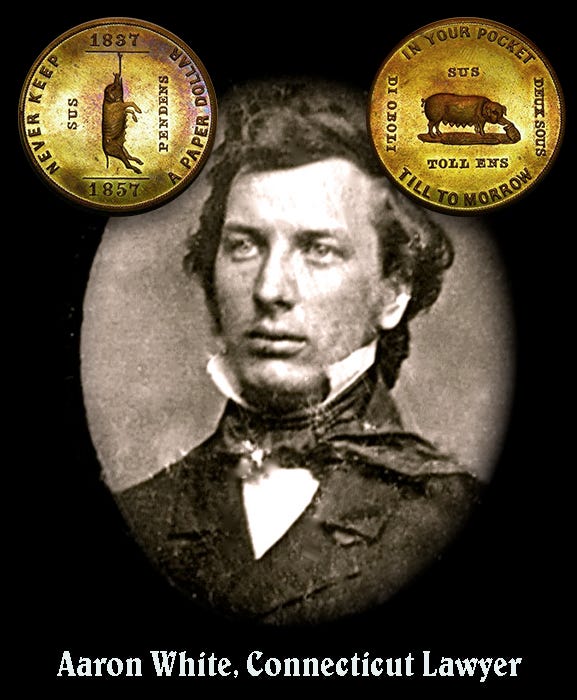

Collins Find (1894)
In 1894, a Washington D.C. Numismatist, Benjamin H. Collin, acquired a $5 bag of 1,000 uncirculated half cents (dated 1828) of the 13-stars variety. Actually, one coin was dated 1811, and the other 999 were brand new 1828 Classic Head Half-Cents, designed and engraved by John Reich. These bright, uncirculated coins account for the many 1828 half cents, displaying a beautifully toned mint red color but with some spotting and staining.
Collins slowly sold these half cents to coin collectors, and they were dispersed in small groups over the next several decades, and when the holdings of famous numismatist F.C.C. “Fred” Boyd were sold in 1955, the last few hundred entered the market.
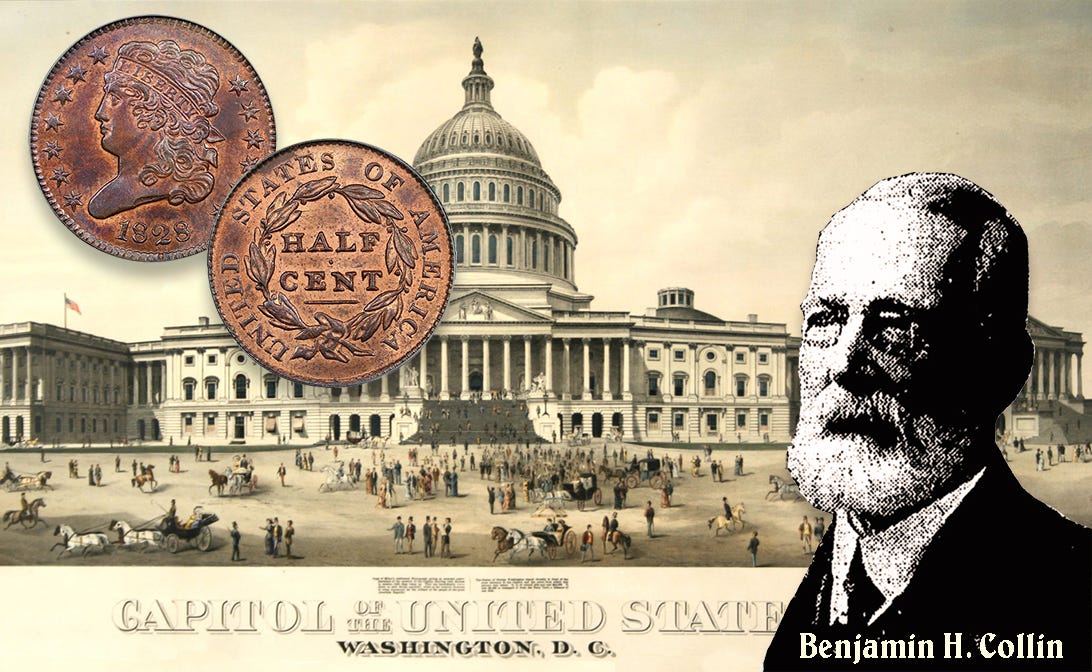

Chapman Hoard (1906)
In 1878, Philadelphia Numismatist Samuel Hudson (S.H.) Chapman joined his brother, Henry Chapman, to form one of the greatest numismatic partnerships ever known. The Chapman Brothers cataloged many of the finest collections to be offered at public auction at that time. After their split in 1906, Henry Chapman acquired a small hoard of 1806 half cents, a cache of coins estimated to contain from 200 to "many hundreds" of copper pieces.
Most had much of their original mint red color with some brown toning. They were mostly spotty red pieces with plenty of bag marks. The half cents of that year showed light striking at the upper part of the wreath. Many surviving coins display varying degrees of wear, some mechanical damage, and active corrosion on the coins.
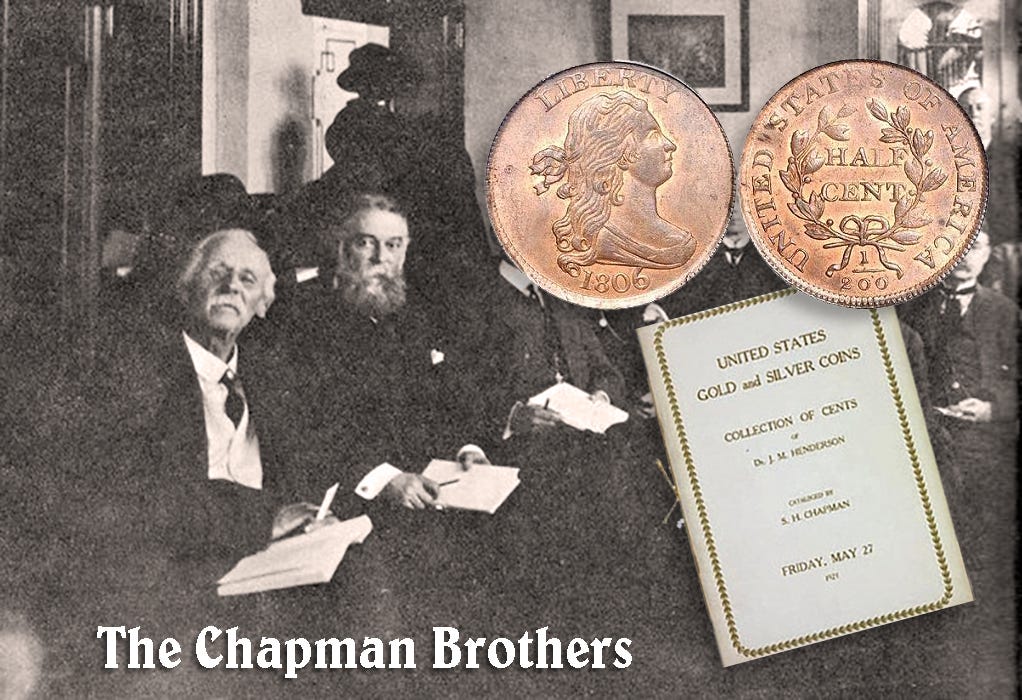

Baltimore Find (1934)
One of the most famous stories of coin hoards in American numismatics is the Baltimore find, which was a cache of at least 3,558 gold coins, all dated before 1857. On August 31, 1934, two teenage boys were playing in the cellar of a rented house at 132 South Eden Street, Baltimore, where they found every boy’s dream: actual buried treasure with over 3,500 pre-1857 gold coins buried in the cellar.
The story is that the boys formed a club, the "Rinky-Dinky-Doos," and were busy digging a hole in the floor of the cellar to bury their secret club papers, playing cards, dice, and poker chips. While digging, their shovel struck something hard, so they reached into the hole and pulled out a $20 gold piece, and then another, and another. So then they really started digging! What the two boys had finally unearthed in two separate pots were 3,558 gold coins dating from the 1830s, 1840s, and 1850s, many in choice condition.
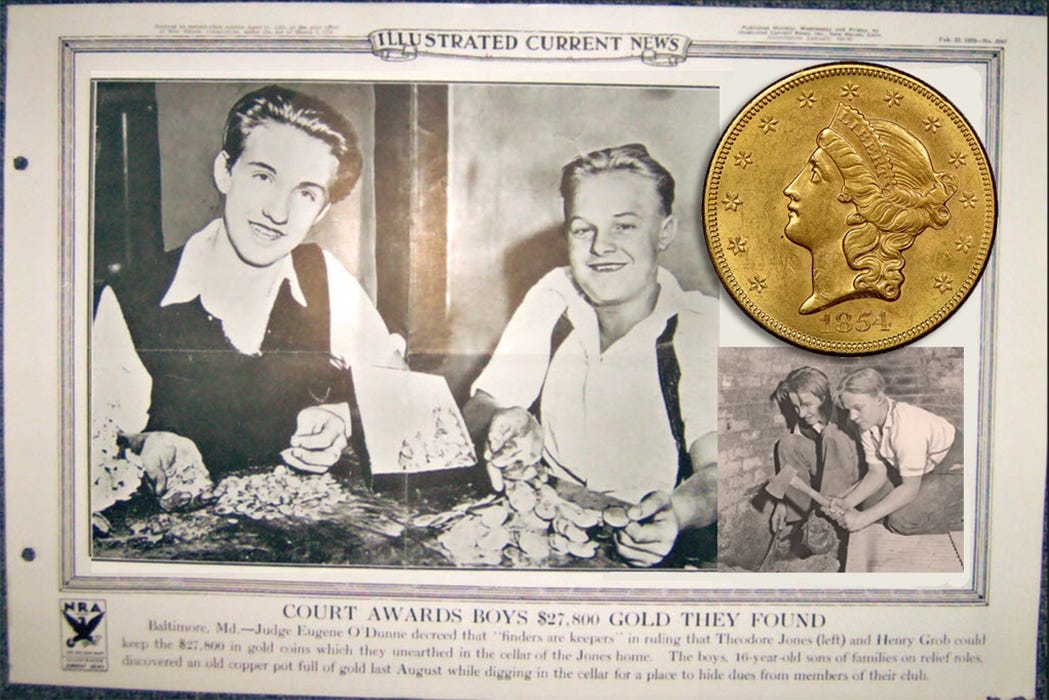

When all was said and done, the two youths were awarded $6,000, though the money would not be available to them until they were 21 years old. Only one of the two boys collected the reward. The other died just before his 21st birthday from pneumonia. In 1935, the 3,558 coins, divided into 438 lots, were auctioned off on May 2, 1935, at the Lord Baltimore Hotel, realizing a sale of almost $20,000. The 3,558 gold coins had a face value of $11,200 and sold for around $20,000, but today, this buried treasure discovery would be worth more than $10 million.
The Redfield Hoard (1974)
One of the most famous silver coin caches in history was the “Redfield Hoard” of Morgan and Peace Silver Dollars. Lavere Redfield was a Los Angeles financier who made his money through oil and stock investments. He was a "hard money" fanatic who hated the government and refused to pay taxes.
In the 1930s, he left L.A. to become a farmer in Reno, Nevada, where he enjoyed looking the part of a poor farmer and was generally considered a cheapskate, but he had a big secret. Mr. Redfield decided to hold much of his capital in silver dollars and had a unique interest in Silver Morgan Dollars, but he wasn’t a coin collector. Friends at local banks would let him know when they had bags of silver dollars, and then he would go in and buy mint bags of Morgan or Peace Dollars in exchange for his paper money. Over three decades, Redfield carried bags of 1,000 silver dollars each to his home and tossed them down the coal chute into his basement, which was hidden behind a false wall.
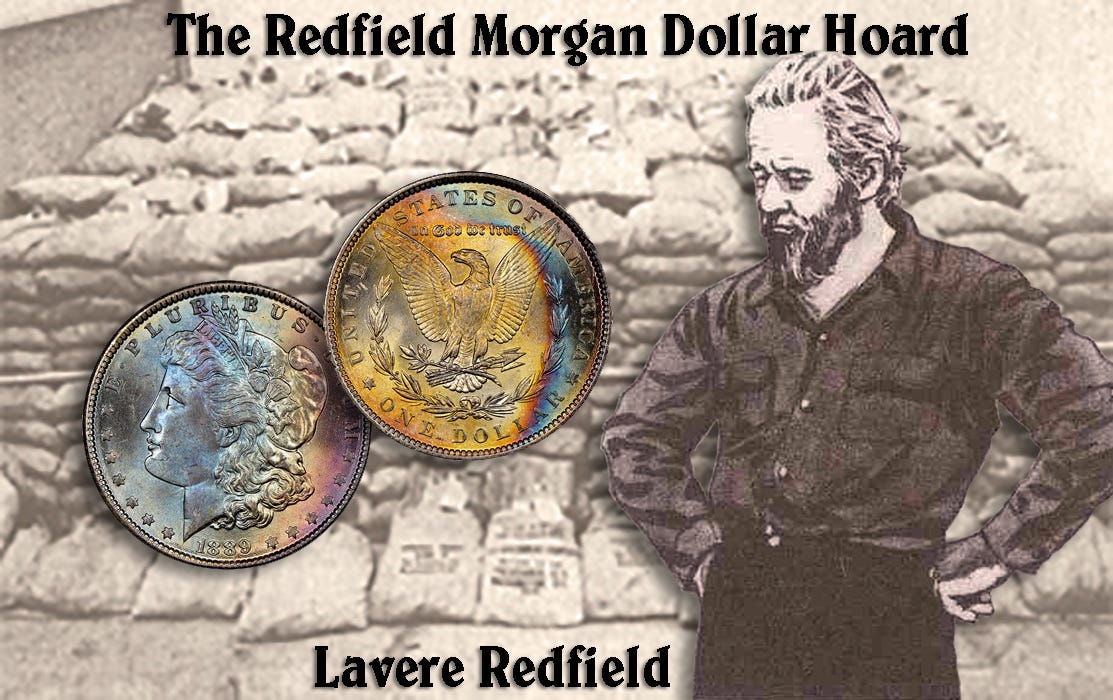

When Mr. Redfield died in 1974, his modest estate was worth about $100 million, and over 600 Mint bags containing over 400,000 silver coins were discovered, untouched, where he had “deposited” them decades before in his basement. The Redfield Hoard was truly a treasure trove. Several original bags of rare dates were found, with a vast number of exceedingly high-quality specimens of common and scarce date silver dollars. A judge decreed that the best way to settle Redfield's estate was to hold an auction for the coins, which sold for $7.3 million.
New Orleans Bank Find (1982)
On October 29, 1982, just after noon, a bulldozer unearthed a cache of a long-hidden hoard of pre-Civil War gold and silver coins believed to have been stored in three wooden boxes in the early 1840s. Once unearthed in public at high noon, the shiny coins caused a number of people to lose their dignity as they attempted to get their piece of the treasure. It was reported that business people in suits and dresses jumped in the dirt and mud, and scrambled to find the newly unearthed treasure, making it very hard for an accurate inventory.
The pieces were primarily Spanish-American issues, but there were hundreds of U.S. coins, including 1840-O and 1841-O Liberty Seated Quarters. With the latest date in the boxes being 1842, the coins would have been in very nice condition as they would have had only a year or so to circulate, if they circulated at all. People at the time did not trust banks, which suggests that the coins were part of some secret reserve of some long-forgotten merchant or bank in New Orleans.
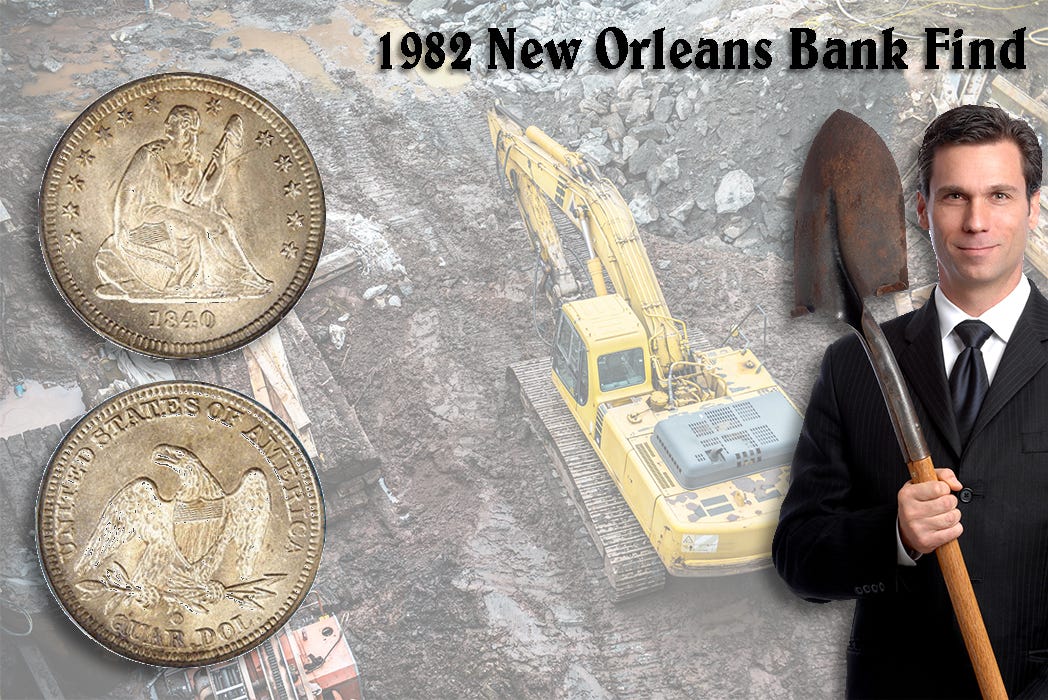

Wells-Fargo Hoard (1996)
The “Wells Fargo Hoard” of 1908 “No Motto” $20 St. Gaudens gold Double Eagles is a special discovery of hidden gems that were stored at a Nevada Wells Fargo Bank in original condition and “untouched” by human hands since 1917. The gold coins were initially designated as a World War I debt payment but were long forgotten in the bank vault for over 80 years.
In 1996, Ron Gillio, noted numismatist, coin dealer, and promoter, negotiated and purchased the largest hoard of high-quality 1908 U.S. $20 gold pieces, approximately 20,000 examples of the Saint-Gaudens 1908 “No Motto” Double Eagles. The hoard was remarkable not only for its size but also for the condition of the coins involved, as some were truly exceptional. It was a mind-boggling number of coins of incredible quality. All coins were mint state, and many were of choice and gem quality. They were offered to the market in 1997 and were dispersed over a period through 1999.
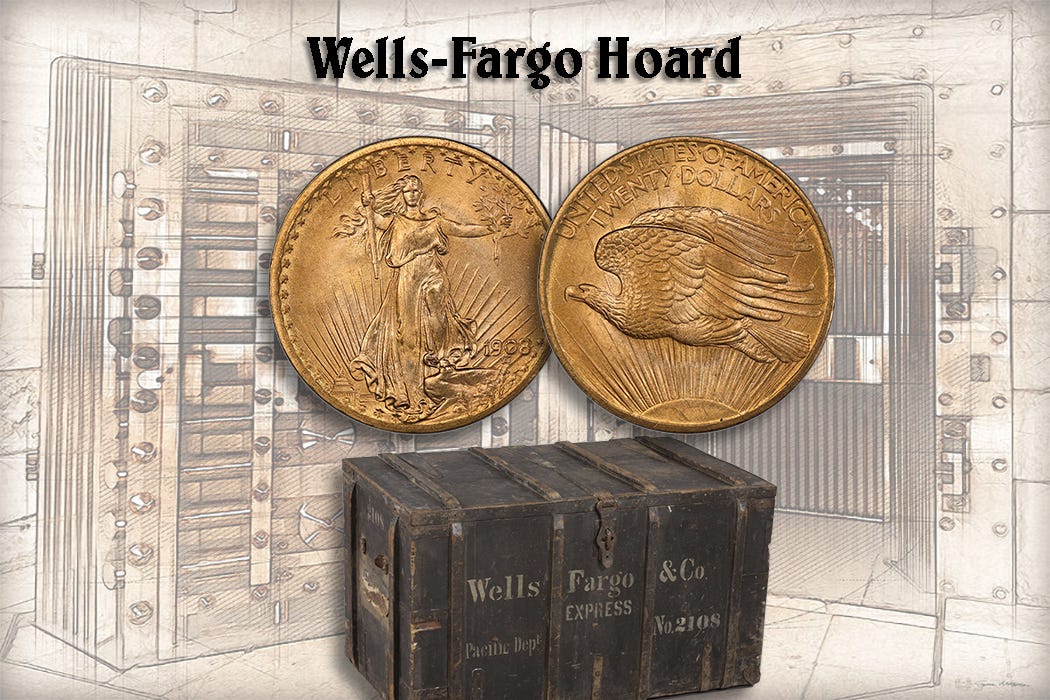

The Binion Hoard (1998)
Ted Binion was a wealthy U.S. gambling executive and one of the sons of famed Las Vegas casino magnate Benny Binion, owner of Binion's Horseshoe, where Ted was involved early on in his father's casino operations. By 1964, Benny was no longer allowed to hold a gaming license because he was a convicted criminal. His sons, Jack and Ted, then took over the day-to-day casino operations. Jack filled the role of president, while Ted became the casino manager.
Ted Binion loved living the high life and partying. Like his father, Benny, he had associations with the Mob and was convicted of drug trafficking charges in 1986. By 1996, he was banned from participating or even entering the family’s casino. Ted stored his massive silver collection in a floor-to-ceiling vault in the basement of the Horseshoe casino. But when Ted’s ties to the family casino were severed, he had to either sell the silver or relocate it to a secure spot, which he decided to do. Binion contracted the construction of an underground vault with MRT Transport, a trucking company owned by Rick Tabish, and transported his silver to the vault, where only he and Tabish knew the combination.
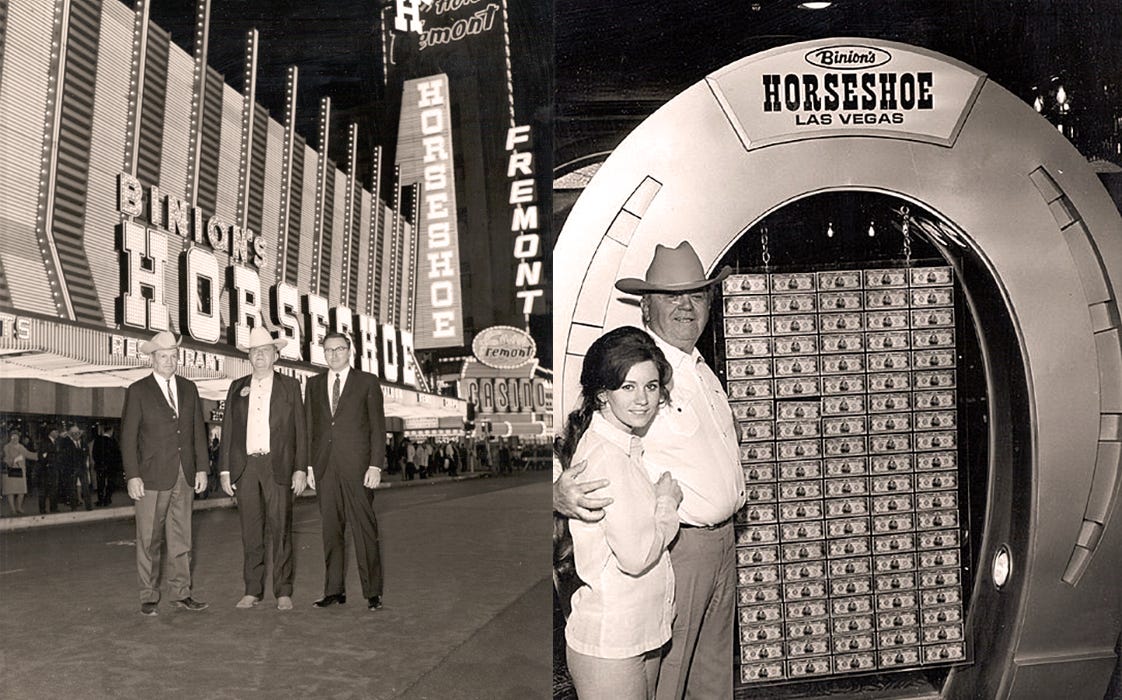

Ted Binion was found dead in 1998 from a suspected drug overdose, but police felt the death was staged. The vault was discovered two days after Binion died, where Rick Tabish was caught unearthing the silver at 2 am in the morning. The 12-foot-deep vault was built on the desert floor on a piece of property Binion owned just outside Vegas. The concrete bunker contained six tons of silver bullion, Horseshoe Casino chips, paper currency, and more than 100,000 rare coins, including Carson City silver dollars, many in mint condition, estimated to be worth between $7 and $14 million.
It was discovered that Tabish was having an affair with Binion’s girlfriend, Sandra Murphy. Both were arrested, initially charged, and convicted in Binion's death but were later granted a new trial and acquitted of the murder.
So, what happened to all of Ted Binion's silver? In November 2001, Spectrum Numismatics International purchased some coins from the Binion Hoard, and NGC (Numismatic Guaranty Company) gave the coins a pedigree of the “Binion Collection,” where they were then sold to the public. Today, coins from these hoards are prized by collectors not only for their quality but also for the personalities and lifestyles of the men who amassed them. Because of this, coins that bear a certified hoard pedigree are among the most highly sought-after.
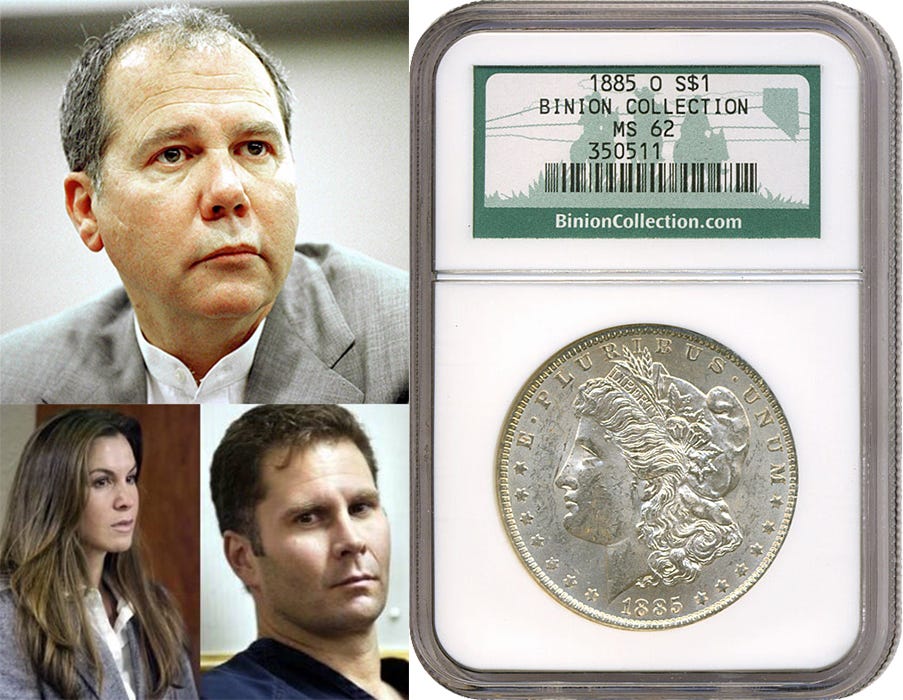

Saddle Ridge Hoard (2014)
In February 2014, a couple was walking their dog on their property after a storm when they noticed a piece of rusted metal jutting out of the ground next to an old tree near an odd-shaped hill that they had nicknamed 'Saddle Ridge.' They used a stick to dig up a rusted can filled with U.S. $20 gold pieces. They returned with a metal detector, eventually uncovering a total of eight cans filled with over 1,400 rare U.S. Liberty Head gold coins minted between 1855 and 1894. The buried treasure of gold coins had a face value of approximately $28,000, worth over $10 million today.
An old newspaper clip from January 1900 revealed that a suspiciously similar amount of gold coins had been stolen from the San Francisco Mint, which led to speculation that the government might stake a claim to the money. The U.S. Mint annual report in 1901 revealed a shortage of $30,000; however, the discovered treasure coins spanned almost 50 years, from 1847 to 1894, with mint marks from San Francisco, Carson City, New Orleans, and Philadelphia. None of the coins were dated 1900, which was the date of the coins stolen from the Mint’s cashier’s vault that year. In 1903, the Chief Clerk at the San Francisco Mint, Walter Dimmick, was found guilty of stealing $30,000 worth of gold coins in 1900. Dimmick went to prison, and the 1,500 gold coins were never found.
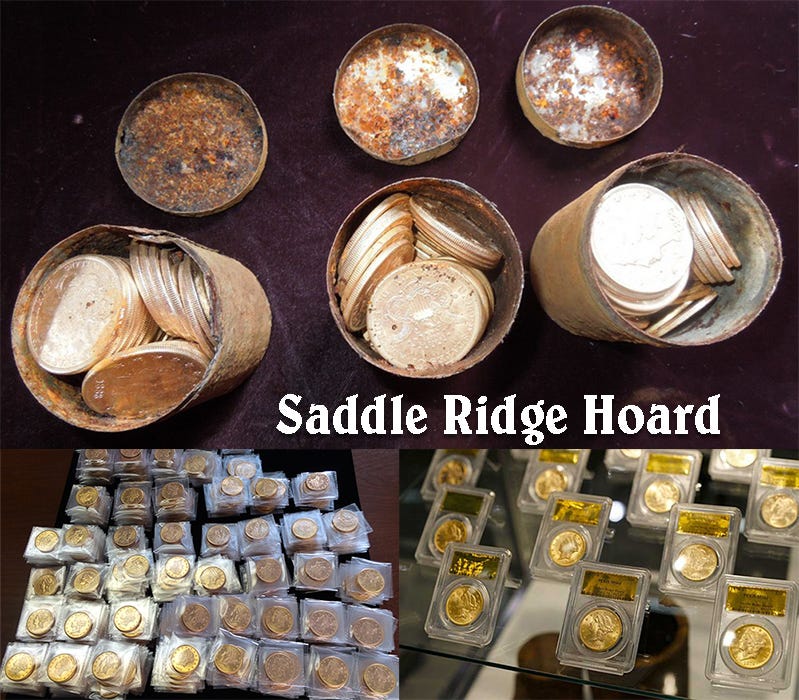

The Saddle Ridge Hoard discovery is one of the most amazing numismatic stories of buried treasure, and the happy couple who discovered the coins got to keep their “Pots of Gold!”
Gold Coins Abroad (1990s - Present)
The $20 Gold Double Eagle was the largest US Gold Coin, and these trusted coins were a natural choice for gold reserves. Millions of gold coins were shipped out of the country to pay U.S. debt and found their way to foreign bank vaults, where they remained untouched for decades. As an added benefit, when the Gold Recall Order of 1933 began, these double eagles in overseas vaults could not be melted.
In the late 1990s and early 2000s, there were some exciting finds of mint state double eagles located in foreign bank vaults. Many high-grade examples of Carson City issues in the Liberty Head series, and hundreds of scarce mint mark varieties of the Saint-Gaudens Double Eagle series, were found. Often, when these hoards are discovered, many pieces filter into the marketplace without any publicity or accounting of the specific varieties found. Yet, these magnificent gold coins traveled the globe and are still being discovered today.
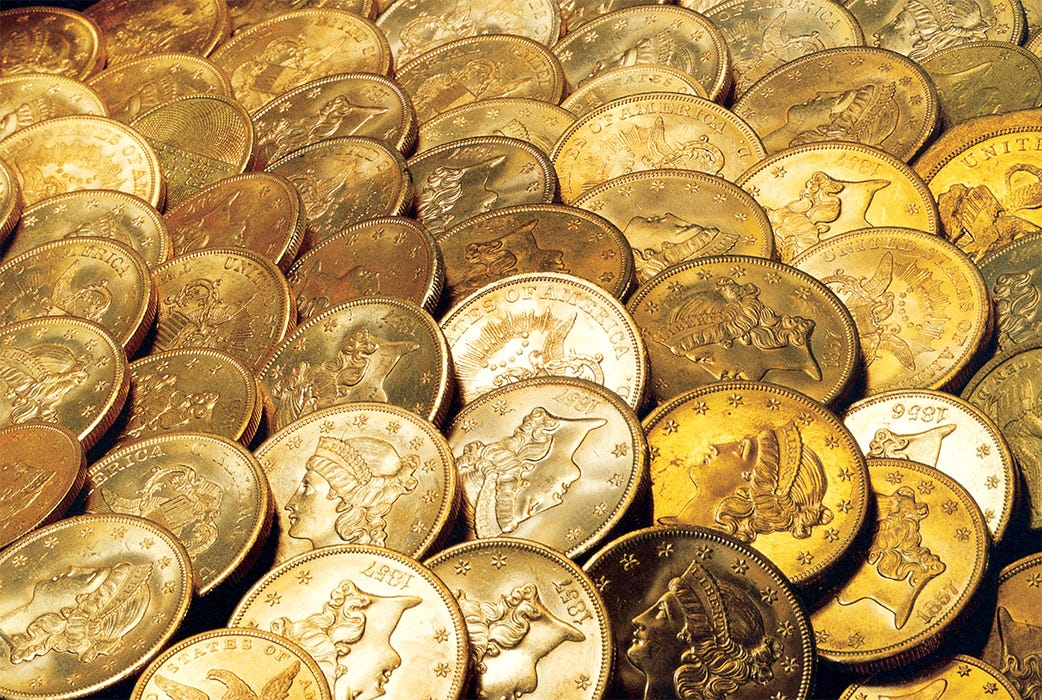

McClaren Silver Dollar Collection
A few years ago, GovMint.com carried another exciting silver dollar hoard, a hoard as unique in flavor and size as those of Redfield or Binion, called The McClaren Collection. Hoard owner Gerald "Jerry" Forsythe is a spirited Midwestern entrepreneur whose investment portfolio has included everything from power plants and farmland to wine vineyards and automotive racing teams. But Jerry also collected coins - a lot of them!
Over the past 30 years, Jerry amassed hoards that include tens of thousands of Buffalo Nickels, Walking Liberty Half Dollars, and vintage silver dollars, to name a few. His McClaren Collection pedigree (a name derived from his Mercedes SLR McLaren super sports car) adorns the Professional Coin Grading Service (PCGS) label for each coin. Like those of other great hoards, this pedigree does more than substantiate ties to an important numismatic release, it also serves as a tie to a collector's story, a story as rich and colorful as the coins themselves.
The Great Kentucky Hoard (2023)
In 2023, a significant gold hoard discovery known as the Great Kentucky Hoard was made on Kentucky farmland. This monumental find included a cache of gold coins from the mid-19th century, primarily consisting of $1 Gold Indians from 1854-1862, which account for 95% of the hoard. The hoard contained around twenty $10 Liberty coins from 1840-1862 and eight $20 Libertys from 1857-1862. A highlight of this discovery was the inclusion of approximately eighteen 1863-P $20 Gold Liberty coins, among the rarest in the $20 Liberty series and often fetching a six-figure price.
All these coins were crafted with 90% gold from various U.S. mints, including Philadelphia, Denver, San Francisco, New Orleans, and Carson City. After professional cleaning and grading by the Numismatic Guaranty Company (NGC), most coins were classified as Extremely Fine to Mint State, with the 1863-P $20 Libertys notably all reaching Mint State. This collection's significance earned it the "Great Kentucky Hoard" pedigree from NGC. With limited availability, enthusiasts had the unique opportunity to procure a piece of this historical, Civil War-era gold coin collection.
It's these stories that make coins from hoards such as the Great Kentucky Hoard so exciting to today's collectors. Collectors always enjoy sharing the tale of an exciting "acquisition" with a friend or family member.
Can You Keep Buried Treasure if You Find It?
So, what if you have discovered buried treasure yourself?
If the treasure or coin hoard was found on your property, there is a common treasure trove rule of law that could be applicable. Essentially, if you find gold, silver, or paper money on your property whose true owner and heirs are believed to be dead or undiscoverable, then you might have a claim to what you have found. However, the application and recognition of this doctrine vary from state to state, and many have supplanted or modified the concept with statutory provisions. Consequently, while the treasure trove principle provides a historical foundation, modern finders of buried valuables must navigate a more complex legal landscape influenced by state-specific laws and considerations. Ultimately, depending on where the lost treasure was discovered, its archeological significance, the local laws of the area, whether previous ownership can be determined, and many other factors, it can be difficult to keep a buried treasure for yourself.
If you know of a coin hoard, contact an expert in handling large numbers of very special coins -- GovMint.com!
Copyright 2020 GovMint. All Rights Reserved. GovMint.com does not sell coins and numismatics as investments, but rather as collectibles. Please review GovMint’s Terms and Conditions, Terms of Use and Privacy Policy before using this website and prior to purchasing from GovMint. All website content is for reference use only and does not constitute investment, legal or financial advice. We encourage the sharing and linking of our information but reproduction of our news and articles without express permission is prohibited. Instead of reproducing, please provide the link to the original article or use the share buttons provided.






